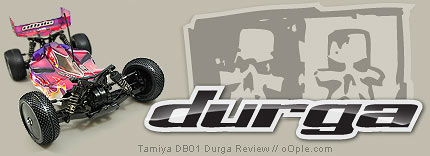|
The steering servo is on the opposite side to the TRF501X - at the front left hand side of the car. A heavy duty servo saver with three metal rings is supplied for the servo – a far better setup than the all-plastic saver on the DF03. I use this same servo saver on the 501X.
Tamiya supply two adaptors for different servo brands, one for Tamiya / Futaba, and the other for KO / Sanwa / Acoms. I’m not sure if Hitec use a different mount but there isn’t one included for that brand.
Assembling the saver isn’t the easiest task since the three metal rings need placing over one another – with the two smaller silver rings going on first. If you start at the ‘open’ end of the rings and push them on a little at a time, or use something to carefully prize the rings open whilst installing, it’s much easier.
For the electrics I was using a Sanwa ERG-VR servo, acquired whilst visiting Japan for the World Championships a couple of months previously – with a 0.07 transit time to 60degrees it was more than capable of handling the Durga.
To provide power to the previously mentioned Peak Vantage 14x2, I was using a new Keyence Zero V Extreme 2002, which has been sitting in my box waiting for an oportunity to be used. This is one of the smoothest and most high tech ESC’s you can buy. |
 |
| The bodyshell has plenty of room for the electrics - even the largest brushless ESC's equipped with fans. The scoops and large cut out (option) mean the durga should have plenty of cooling despite the enclosed chassis. |
|
To control it all, I was using the Sanwa DSSS 2.4ghz receiver from the review a couple of months ago. The manual shows the receiver in space in front of the motor – with the ESC at the read of the car. Depending on the size of the electrics used you’re free to place them where you wish, since there are aerial mounts both in front and behind the motor, with corresponding ‘dimples’ on the body shell so you can choose where to position things.
A black plastic cable tidy is provided to route any wires over the motor between ESC and receiver. I went with the receiver up front and ESC at the rear, since I could route the wires from the battery through the rear belt tunnel. There’s plenty of room at the rear for even the largest ESC’s, but the receiver area isn’t quite so large – still, there was plenty of room for the small Sanwa receiver I was using.
Tamiya really consider this a racer and provide an AMB hand out transponder mount as standard – which can be attached to the chassis on the right in front of the cells. Even the TRF 501X didn’t come with anything like this. Since I was going to use a Personal Transponder I didn't need the mount, placing the PT just in front of the receiver on top of the servo. |
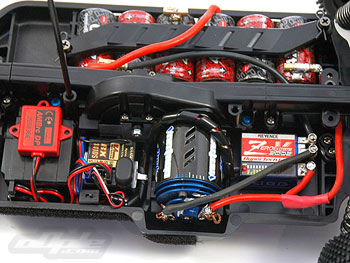 |
The main appeal, other than the price of the Durga, has to be its ability to use stick pack batteries. In a race-level 4WD buggy this is quite rare – and it’s easy to forget just how many people want cars like this but don’t want to use saddle style packs.
The Durga will fit the latest LiPo packs too – again giving the car an advantage over its more expensive competitors, since there is still no wide spread options for saddle pack LiPo’s.
All my race-level cells are in 'saddle pack' style formation - but these fit with no problems. I chose to run with one half of the pack turned to bring the connector to the middle of the pack - this enabled me to run a shorter wire from the ESC.
With the cells running down one side, and all the other electrics on the opposing side – you’d be forgiven for thinking the car might balance out quite well. I weighed the cells I was running at 448g, and the rest of the electrics came to 289g. Quite a difference between the left and right sides. |
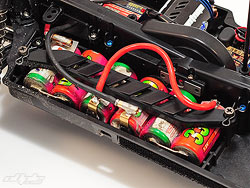 |
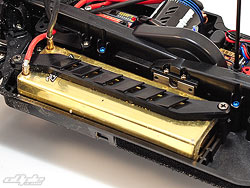 |
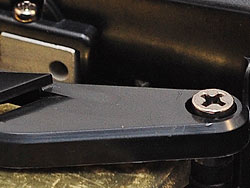 |
| Stick, side-by-side or saddle pack cells will fit without problems. I used saddle packs with 'corally' style connectors. |
| The Trakpower Lipo fits well - but since the pack doesn't sit properly in the tray, the strap needs to be lifted up a little. Just a case of unscrewing the cell posts a few turns. |
|

The Durga uses what is rapidly becoming a near industry standard wheel fitment for 4WD buggies, just like its bigger brother the 501X. The front of the car uses a small Losi-style hex and the rear uses a pin through the axle which locks into a slot on the rear wheel, again borrowed from the Losi line of cars.
The pins through both front and rear axles are a loose fit and will fall out very easily – a dab of the provided Anti-Wear grease on the pins before inserting will keep them in place.
The Wheels are also identical in all but colour to those supplied with the TRF501X, a copy of the Losi front dish wheel and Proline rear B4 wheels. Unlike the 501X though, the Durga comes supplied with tyres and foam inserts – the same as those supplied with the DF03 / Dark Impact. |
 |
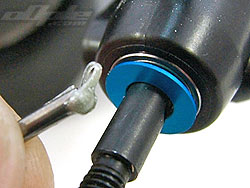 |
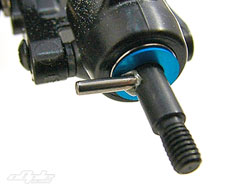 |
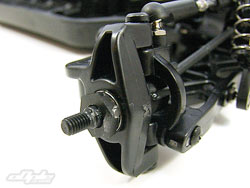 |
A dab of the supplied 'Anti Wear' grease will stop the pins falling out. |
The rear pin half-way inserted. |
The small front 'losi-style' hex. |
|
